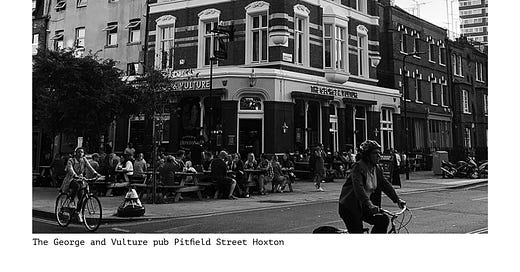I do not know who the George in the name George and Vulture was or why he should be associated with a vulture. However, the name does the most important job of a good pub name which is to be unforgettable. It might recall one of the George monarchs and a member of his menagerie, but I have not found evidence for this association.
I did however find this:
‘--- and Mr Pickwick and Sam took up their present abode in very good, old fashioned and comfortable quarters, to wit, The George and Vulture Tavern and hotel, George Yard, Lombard Street.
Mr Pickwick had dined, finished his second pint of particular port, pulled his silk handkerchief over his head, put his feet on the fender, and thrown himself back in an easy chair, when the entrance of Mr Weller with his carpet bag, aroused him from his tranquil meditations.’
The Pickwick Papers – Charles Dickens
The George and Vulture in Pitfield Street is a sister pub to the original in the City, an ancient pub whose history that can be traced back to the mid twelfth century. Dickens enjoyed drinking there and absorbed aspects of the place to add vivid reality to his stories relating the adventures of Mr Pickwick. Celebrations of Dickens work and meetings of the City Pickwick Club are regular events held at the Lombard Street George and Vulture.
London is rich with these associations of real and imagined histories, shared memories, social narratives and inventive stories transferring into the identity of places. The diagram below summarises the process. Artistic imagination borrows aspects of real places and includes them in creative fictions and in compelling tales of historical events. The fictions and narratives are then celebrated with events, rituals and performances reinforcing the association between the narrative and the place. Through this process both the real events and invented stories, both sacred and the secular, become embedded into urban geography.
It is surely a sign of a successful place when living architecture provides more than merely space to accommodate a function but additionally ignites the creativity of users in a dance of imagination and location.
There is no recorded connection that I can find between Dickens and Pitfield Street, although given the accounts of his energetic wanderings across London he may well have walked these streets. He is said to have given talks in nearby Hoxton Hall. He may even have performed readings of his very popular adventures of Mr Pickwick there.
The George and Vulture in Pitfield Street was built in the 1870’s. Its naming is an example of creative borrowing to established nostalgic associations of one place transferred to another. The hope being that the cosy comfort and ease associated with the established Lombard Street George and Vulture will break out in the new one.
The opening date of the new pub is significant. A printed epitaph circulating at that time read:
‘To the Memory of Charles Dickens (England's most popular author) who died at his residence, Higham, near Rochester, Kent, 9 June 1870, aged 58 years. He was a sympathiser with the poor, the suffering, and the oppressed; and by his death, one of England's greatest writers is lost to the world.
The George and Vulture name might well have been selected in memory of the great writer. He used the name of the Lombard Street original to give greater reality to his characters by locating their adventures in real London spaces. By this process Dickens shifting fictions have become fixed into the city that he came to represent. To mark his death the name was borrowed in the hope of transferring the association to the new setting in Pitfield Street.
Note: First published by urban narrative.com





Bravo, a good narrative about urban narrative